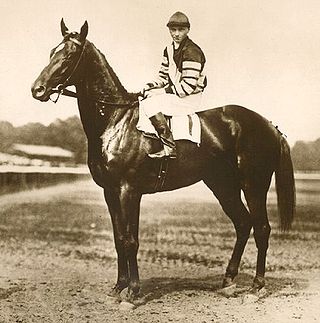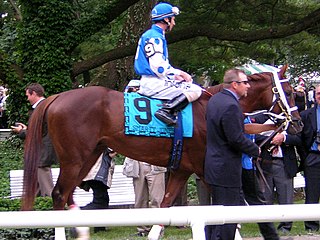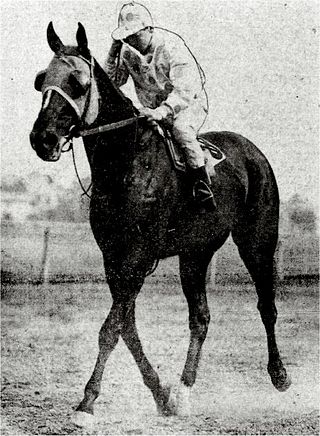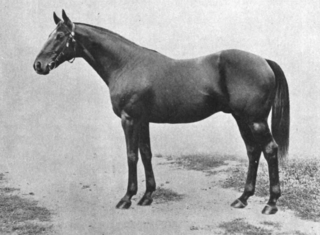
The Preakness Stakes is an American thoroughbred horse race held annually on Armed Forces Day, the third Saturday in May at Pimlico Race Course in Baltimore, Maryland. The Preakness Stakes is a Grade I race run over a distance of 1+3⁄16 miles on dirt. Colts and geldings carry 126 pounds (57 kg); fillies 121 pounds (55 kg). It is the second jewel of the Triple Crown, held two weeks after the Kentucky Derby and three weeks before the Belmont Stakes.

The Belmont Stakes is an American Grade I stakes race for three-year-old Thoroughbreds run at Belmont Park in Elmont, New York. It is run over the worldwide classic distance of 1+1⁄2 miles. Colts and geldings carry a weight of 126 pounds (57 kg); fillies carry 121 pounds (55 kg). The race, nicknamed The Test of the Champion, The Test of Champions and The Run for the Carnations, is the traditional third and final leg of the Triple Crown. It is usually held on the first or second Saturday in June, five weeks after the Kentucky Derby and three weeks after the Preakness Stakes. The 1973 Belmont Stakes and Triple Crown winner Secretariat holds the track record of 2:24.

Man o' War was an American Thoroughbred racehorse who is widely regarded as one of the greatest racehorses of all time. Several sports publications, including The Blood-Horse, Sports Illustrated, and the Associated Press, voted Man o' War as the best American racehorse of the 20th century. During his racing career, just after World War I, Man o' War won 20 of 21 races and $249,465 in purses. He was the unofficial 1920 American horse of the year and was honored with Babe Ruth as the outstanding athlete of the year by The New York Times. He was inducted into the National Museum of Racing and Hall of Fame in 1957. On March 29, 2017, the museum opened a special exhibit in his honor, "Man o' War at 100".

Sir Barton was a champion American Thoroughbred racehorse who is the first winner of the American Triple Crown.

Smarty Jones is a champion Thoroughbred racehorse who won the 2004 Kentucky Derby and Preakness Stakes and came second in the Belmont Stakes.
The Sanford Stakes is an American Thoroughbred horse race held annually during the third week of July at the Saratoga Race Course in Saratoga Springs, New York. A six furlong sprint race, the Grade III event is open to two-year-old horses.
The Withers Stakes is a Grade III American Thoroughbred horse race for three years old horses over the distance of 1+1⁄8 miles on the dirt scheduled annually in February at Aqueduct Racetrack in Queens, New York. The event currently carries a purse of $250,000.

John Patrick Loftus was an American thoroughbred horse racing Hall of Fame jockey.

Peter Pan (1904–1933) was an American Thoroughbred racehorse and sire, bred and raced by prominent horseman, James R. Keene. As winner of the Belmont Stakes, the Brooklyn Derby and the Brighton Handicap, he was later inducted into the National Museum of Racing and Hall of Fame. His progeny included many famous American racehorses, including several winners of the Kentucky Derby and the Preakness Stakes.
Johren (1915–1932) was a Thoroughbred racehorse who competed in the United States. His most important win came in the 1918 Belmont Stakes.

In the United States, the Triple Crown of Thoroughbred Racing, commonly known as the Triple Crown, is a series of horse races for three-year-old Thoroughbreds, consisting of the Kentucky Derby, Preakness Stakes, and Belmont Stakes. The three races were inaugurated in different years, the last being the Kentucky Derby in 1875. The Triple Crown Trophy, commissioned in 1950 but awarded to all previous winners as well as those after 1950, is awarded to a horse who wins all three races and is thereafter designated as a Triple Crown winner. The races are traditionally run in May and early June of each year, although global events have resulted in schedule adjustments, such as in 1945 and 2020.
Edward Elbert Ambrose was an American jockey in Thoroughbred horse racing. In the 1910s and 1920s he rode for top owners such as Harry Payne Whitney, Willis Sharpe Kilmer, and Walter M. Jeffords.

Milkmaid was an American two-time Champion Thoroughbred racehorse. She was bred by J. Hal Woodford at his farm in Bourbon County, Kentucky. Woodford had bred and raced the 1907 Kentucky Derby winner, Pink Star. Out of the mare, Nell Olin, her sire was the British import, Peep o' Day, a son of the great Ayrshire who won the 1888 2,000 Guineas Stakes and Epsom Derby then just missed winning the British Triple Crown when he ran second in the St. Leger Stakes.
Pavot was an American Thoroughbred Champion racehorse. In a career that lasted from 1944 to 1946 he ran thirty-two times and won fourteen races. He was the leader of his generation in 1944 when he was named American Champion Two-Year-Old Colt. The following year he recorded his most important win in the Belmont Stakes.
Bostonian was an American Thoroughbred racehorse. The son of Broomstick out of a Peter Pan mare Yankee Maid, Bostonian is best remembered for posting a 1-1/2 length win over his stablemate and Kentucky Derby Champion Whiskery in the mile and three sixteenth $65,000 Preakness Stakes at Pimlico Race Course on May 9, 1927
The 1928 Preakness Stakes was the 53rd running of the Preakness. The race took place on Friday, May 11, 1928, eight days before the Kentucky Derby making it the first leg of the U.S. Triple Crown series. A horse race for three-year-old thoroughbreds, it carried a total purse of $71,370. It was run on a track rated fast in a final time of 2:00 1/5. Ridden by future U.S. Racing Hall of Fame inductee Raymond Workman, Victorian won the race by a nose over runner-up Toro. Nassak, the betting favorite from the powerful Rancocas Stable finished a distant 11th. The fifth-place finisher, Sun Beau, went on to a brilliant racing career and was voted U.S. Champion Older Horse in three straight years culminating with his 1996 induction into the U.S. National Museum of Racing and Hall of Fame.

Wildair was an American Thoroughbred racehorse bred and raced by Exemplar of Racing Harry Payne Whitney and trained by U.S. Racing Hall of Fame inductee, James Rowe Sr. Wildair's most important race win came in the 1920 Metropolitan Handicap, one of the most prestigious American races outside of the Triple Crown series.
The Empire City Derby was an American Thoroughbred horse race held annually from 1917 through 1933 at Empire City Race Track in Yonkers, New York. A race for three-year-old horses of either sex, the event was contested at a mile and one-eighth at inception until 1920 when it was set at what became known as the "Derby distance" of a mile and one-quarter. With the Brooklyn Derby at Belmont Park having changed its name to the Dwyer Stakes, the Empire City Derby was then the only Derby event in the Northeastern United States.
The Chesapeake Stakes was an important American Thoroughbred horse race for three-year-old horses of either sex contested on dirt over a distance of a mile and one-sixteenth at Havre de Grace Racetrack in Havre de Grace, Maryland. Run from 1920 until the track closed after the 1950 edition, the race usually run in late April race was a last major prep before the Kentucky Derby. For owners who had not nominated their horse for the Derby it was a chance to test their horse's ability against some of the best three-year-olds in the country, a number of which they would undoubtedly encounter in the ensuing Preakness Stakes.
The Eastern Shore Stakes was an American Thoroughbred horse race run between 1913 and 1949 at Havre de Grace Racetrack, in Havre de Grace, Maryland. A race for two-year-old horses of either sex, it was inaugurated and run for most of its existence as the Eastern Shore Handicap.








